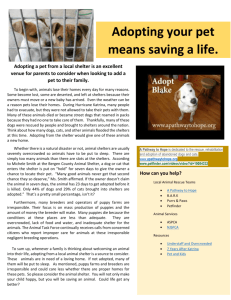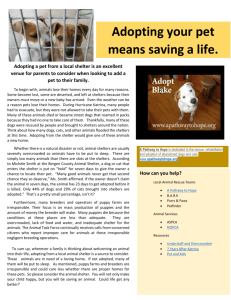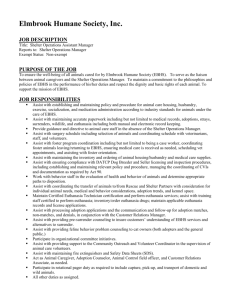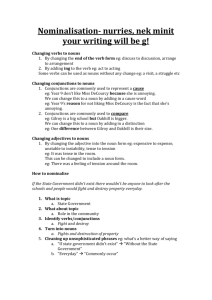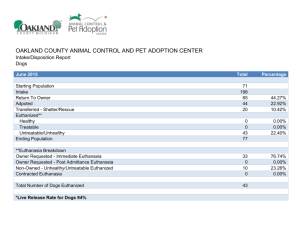Research paper - WordPress.com
advertisement
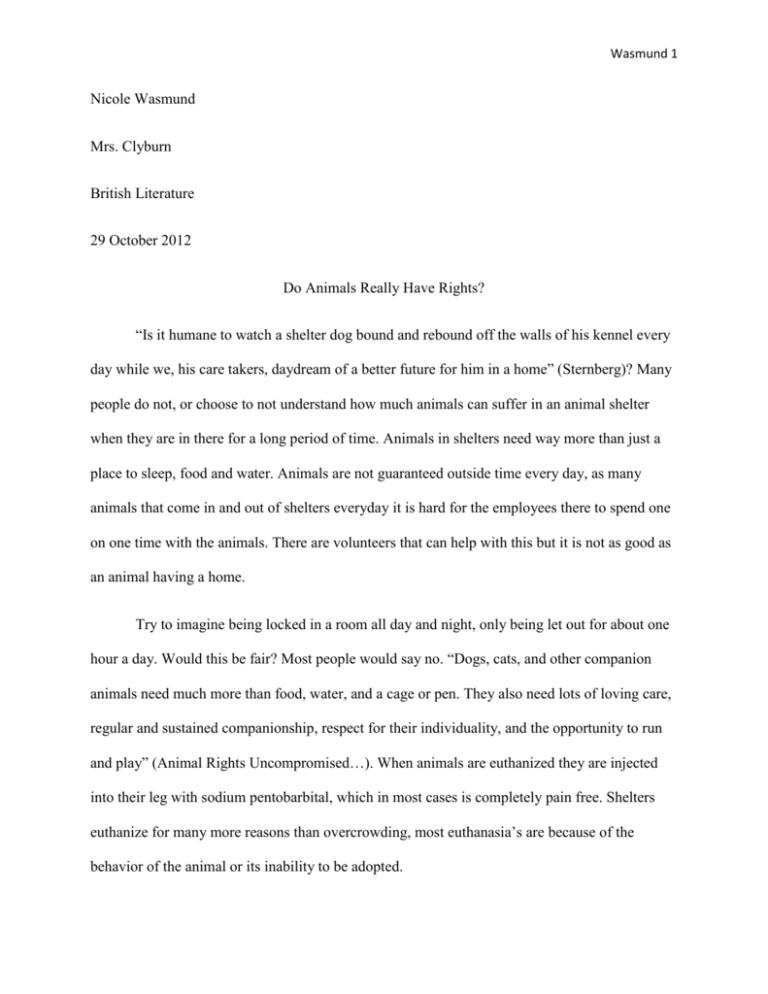
Wasmund 1 Nicole Wasmund Mrs. Clyburn British Literature 29 October 2012 Do Animals Really Have Rights? “Is it humane to watch a shelter dog bound and rebound off the walls of his kennel every day while we, his care takers, daydream of a better future for him in a home” (Sternberg)? Many people do not, or choose to not understand how much animals can suffer in an animal shelter when they are in there for a long period of time. Animals in shelters need way more than just a place to sleep, food and water. Animals are not guaranteed outside time every day, as many animals that come in and out of shelters everyday it is hard for the employees there to spend one on one time with the animals. There are volunteers that can help with this but it is not as good as an animal having a home. Try to imagine being locked in a room all day and night, only being let out for about one hour a day. Would this be fair? Most people would say no. “Dogs, cats, and other companion animals need much more than food, water, and a cage or pen. They also need lots of loving care, regular and sustained companionship, respect for their individuality, and the opportunity to run and play” (Animal Rights Uncompromised…). When animals are euthanized they are injected into their leg with sodium pentobarbital, which in most cases is completely pain free. Shelters euthanize for many more reasons than overcrowding, most euthanasia’s are because of the behavior of the animal or its inability to be adopted. Wasmund 2 “Euthanasia literally means “good death” and true euthanasia- delivered by and intravenous injection of sodium pentobarbital- is painless quick and dignified” (Euthanasia). Resulting from the extremely high number of animals that cannot find homes, most people feel that euthanasia is the most peaceful way to release an animal into the world. Most all shelters across the United States are taking precautions to prevent the excessive breeding of animals. When animals enter the shelter they are “fixed” which means the female dogs and cats are spayed, and the male dogs and cats are neutered. This means the animals are unable to produce again. “The number of animals euthanized each year has decreased dramatically over the past four decades, from some 20 million in 1970 to about 3 million in 2011” (Mach). Since the 1970s, the numbers of dogs and cats have doubled to 160 million. This does not always mean there are more animals coming into shelters, people now understand more the care that animals need and deserve, and do not just drop their animals off at shelters when they or their children loose interest anymore. Stray animals that are picked up on the side of the road are the hardest to find homes for because of the teamed personality they have developed in order to try and survive on the streets. Animals that have previously lived in a home with a family have more of a chance of being adopted because they have a more open personality. Imagine walking through a lunch room looking for a place to sit, who would be more appealing, the person sitting there doing their homework, not wanting to interact with anyone, or the person having a good time talking with their friends. Animals are the same way; most people walking through a shelter are going to appeal more to the animal that wants to play rather than the animal hiding in the back of their cage scared to death. Wasmund 3 There are animals entering and leaving animal shelters every day. “Approximately 6 to8 million animals are handled by animal shelters in the U.S. each year” (Euthanasia). Most of these animals are adopted into a home, but there are still millions of animals of that are left with nowhere to go. “Nearly 4 million unwanted dogs and cats are left with nowhere to go” (Euthanasia). Animal shelters do not have nearly enough room to house all of the animals that are left at the shelter until they die naturally. Even if there was space for all of the animals they would not get the attention and care that they need to live happily. There is always going to be people that are completely against euthanizing animals, but if you look at the facts there is no way to humanely house all of these unwanted animals till they are adopted. The longer the animal is in the shelter, the less likely it is to be adopted out. It would be cruel to hold an animal in a shelter for their life until they die a natural death. When you euthanize an animal they peacefully pass on and do not have to suffer. Wasmund 4 Works Cited "Animal Rights Uncompromised: Euthanasia." Http://www.peta.org. N.p., n.d. Web. <http://www.peta.org/about/why-peta/euthanasia.aspx>. "Euthanasia." Http://www.peta.org. N.p., n.d. Web. <http://www.peta.org/issues/companion-animals/euthanasia.aspx>. "Euthanasia: The Compassionate Option." Http://www.peta.org. N.p., n.d. Web. <http://www.peta.org/issues/companion-animals/euthanasia-the-compassionate-option.aspx>. Interlandi, Jeneen. "PETA and Euthanasia." The Daily Beast. Newsweek/Daily Beast, 27 Apr. 2008. Web. 19 Oct. 2012. <http://www.thedailybeast.com/newsweek/2008/04/27/peta-andeuthanasia.html>. Mach, Andrew. "Behind the Big Drop in Euthanasia for America's Dogs and Cats." The Christian Science Monitor. The Christian Science Monitor, 10 Feb. 2012. Web. 19 Oct. 2012. <http://www.csmonitor.com/USA/Society/2012/0210/Behind-the-big-drop-in-euthanasia-forAmerica-s-dogs-and-cats>. Sternburg, Sue. "Some Thoughts on Euthanasia from APDT's Gimme Shelter." Petfinder.com. N.p., n.d. Web. 19 Oct. 2012. <http://www.petfinder.com/for-shelters/thoughtseuthanasia-dogs-shelters.html>.

